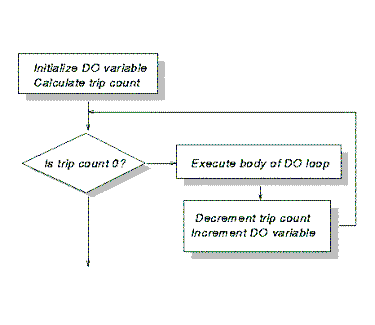7.1 How to repeat a section of program
7.4 What is the Trip-count and how to calculate it
7.5 How to use the WHILE Statement
LOOPS AND FORMAT
DO LOOP - General form :
where
! PROGRAM P42 ! ! IMPLICIT NONE INTEGER :: KS,LT,I,J PRINT *, 'This is Program >>P42 - Nested DO loops' ! ! Two nested DO loops KS=0 LT=0 L1: DO I=1,20,2 L2: DO J=I,25 KS=KS+J END DO L2 LT=LT+I PRINT *,I,KS,LT END DO L1 STOP END PROGRAM P42
LOOP CONTROL CONSTRUCT
A) Simple example: repeat
a block 100 times
DO K=1,100
READ *,A,B,C
SEMI = (A+B+C)/2.0
PRINT *,A,B,C,SEMI
END DO
B) General form:
DO var = init, limit, inc
.
.
.
END DO
THE TRIP COUNT
C) Computing the trip count
:
Trip count = (limit - init +
inc)/(inc)
DO K=1,100,2
READ *,A,B,C
SEMI = (A+B+C)/2.0
PRINT *,A,B,C,SEMI
END DO

D) Be careful with real
numbers ( ONLY VALID WITH FORTRAN 77 ) :
SUM = 0.0
DO X=0.0, 1.0, 0.1
SUM = SUM + X
PRINT *,X,SUM
END DO
This brings out some special
cases. If for some reason the following loop was programmed
READ *,N
DO 33 K=11,N
33 N=N+K
PRINT *,N
and by mistake the value of N
read in was less than 11, then the trip count for this loop would
be set to zero. If N has a value of 7, the statement labeled
33 is not executed and the PRINT statement will output the original
value of N, namely 7.
A flowchart for the organization
of a FORTRAN 77 DO loop is shown in the next diagram. A few further
examples show that the DO statement itself can be quite complex.
On to the next lecture
Go back to lecture menu